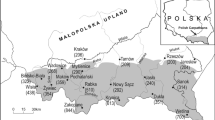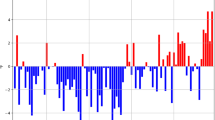Abstract
Radon anomalies have been used for predicting earthquakes since radon is one of the most effective precursors. The radon time series analysis is the crucial phase to demonstrate the relationship between earthquakes and radon anomalies. A major part of the analysis is the characterization of its periodic and non-periodic components. This study aims to reveal the periodic components in the radon time series of the Manisa Fault Zone (MFZ). The results show that atmospheric pressure component S1 has been encountered in the radon time series. It is also found that radon concentrations were quite variable throughout the study period.






Similar content being viewed by others
References
Monnin MM, Seidel JL (1992) Radon in soil-air and in groundwater related to major geophysical events: a survey. Nucl Inst Methods Phys Res A 314:316–330. https://doi.org/10.1016/0168-9002(92)90975-A
Segovia N, Mena M, Pena P, Geofluides-bassins-eau L (1995) Short and longterm radon in soil monitoring for geophysical purposes. Radiat Meas 25:547–552
Toutain JP, Baubron JC (1999) Gas geochemistry and seismotectonics: a review. Tectonophysics 304:1–27. https://doi.org/10.1016/S0040-1951(98)00295-9
Cigolini C, Bergese P, Marino C, Pra P (2001) High-resolution radon monitoring and hydrodynamics at Mount Vesuvius. Geophys Res Lett 28:4035–4038
Burton M, Neri M, Condarelli D (2004) High spatial resolution radon measurements reveal hidden active faults on Mt. Etna Geophys Res Lett 31:1–4. https://doi.org/10.1029/2003GL019181
Reddy DV, Sukhija BS, Nagabhushanam P, Kumar D (2004) A clear case of radon anomaly associated with a micro-earthquake event in a stable continental region. Geophys Res Lett 31:1–4. https://doi.org/10.1029/2004GL019971
Alparone S, Behncke B, Giammanco S et al (2005) Paroxysmal summit activity at Mt. Etna (Italy) monitored through continuous soil radon measurements. Geophys Res Lett 32:1–4. https://doi.org/10.1029/2005GL023352
Hartmann J, Levy JK (2005) Hydrogeological and gasgeochemical earthquake precursors—A review for application. Nat Hazards 34:279–304. https://doi.org/10.1007/s11069-004-2072-2
Immè G, La Delfa S, Lo Nigro S et al (2006) Soil radon concentration and volcanic activity of Mt. Etna before and after the 2002 eruption. Radiat Meas 41:241–245. https://doi.org/10.1016/j.radmeas.2005.06.008
Içhedef M, Saç MM, Harmanşah C, Taskopru C (2014) Two year evolution of radon emission and tectonic movements in tuzla fault, seferihisar-İzmir. Appl Radiat Isot 86:102–108. https://doi.org/10.1016/j.apradiso.2013.12.011
Tarakçi M, Harmanşah C, Saç MM, Içhedef M (2014) Investigation of the relationships between seismic activities and radon level in Western Turkey. Appl Radiat Isot 83:12–17. https://doi.org/10.1016/j.apradiso.2013.10.008
Riggio A, Santulin M (2015) Earthquake forecasting: a review of radon as seismic precursor. Boll di Geofis Teor ed Appl 56:95–114. https://doi.org/10.4430/bgta0148
Ülküm Ö, Taşköprü C, İçhedef M et al (2018) Ground water radon anomalies in Bodrum Peninsula. Terra Nov 30:152–161. https://doi.org/10.1111/ter.12320
Buttafuoco G, Tallarico A, Falcone G (2007) Mapping soil gas radon concentration: a comparative study of geostatistical methods. Environ Monit Assess 131:135–151. https://doi.org/10.1007/s10661-006-9463-7
Sahoo SK, Katlamudi M, Shaji JP et al (2018) Influence of meteorological parameters on the soil radon (Rn222) emanation in Kutch, Gujarat, India. Environ Monit Assess. https://doi.org/10.1007/s10661-017-6434-0
Steinitz G, Piatibratova O, Barbosa SM (2007) Radon daily signals in the Elat Granite, southern Arava, Israel. J Geophys Res Solid Earth 112:1–19. https://doi.org/10.1029/2006JB004817
Cigolini C, Laiolo M, Coppola D (2007) Earthquake-volcano interactions detected from radon degassing at Stromboli (Italy). Earth Planet Sci Lett 257:511–525. https://doi.org/10.1016/j.epsl.2007.03.022
Kamalakar DV, Vinutha PR, Kaliprasad CS, Narayana Y (2022) Seasonal variation of indoor radon, thoron and their progeny in Belagavi district of Karnataka, India. Environ Monit Assess. https://doi.org/10.1007/s10661-022-09931-8
Ghosh D, Deb A, Sengupta R (2009) Anomalous radon emission as precursor of earthquake. J Appl Geophys 69:67–81. https://doi.org/10.1016/j.jappgeo.2009.06.001
Walia V, Su TC, Fu CC, Yang TF (2005) Spatial variations of radon and helium concentrations in soil-gas across the Shan-Chiao fault, Northern Taiwan. Radiat Meas 40:513–516. https://doi.org/10.1016/j.radmeas.2005.04.011
Finkelstein M, Eppelbaum LV, Price C (2006) Analysis of temperature influences on the amplitude-frequency characteristics of Rn gas concentration. J Environ Radioact 86:251–270. https://doi.org/10.1016/j.jenvrad.2005.09.004
Kumar A, Walia V, Arora BR et al (2015) Identifications and removal of diurnal and semidiurnal variations in radon time series data of Hsinhua monitoring station in SW Taiwan using singular spectrum analysis. Nat Hazards 79:317–330. https://doi.org/10.1007/s11069-015-1844-1
Steinitz G, Piatibratova O, Gazit-Yaari N (2013) Influence of a component of solar irradiance on radon signals at 1 km depth, Gran Sasso, Italy. Proc R Soc A Math Phys Eng Sci. https://doi.org/10.1098/rspa.2013.0411
İçhedef M, Giammanco S, Neri M et al (2020) In soil radon anomalies and volcanic activity on Mt. Etna (Italy). J Environ Radioact. https://doi.org/10.1016/j.jenvrad.2020.106267
Aumento F (2002) Radon tides on an active volcanic island: Terceira, Azores. Geofis Int 41:499–505. https://doi.org/10.22201/igeof.00167169p.2002.41.4.501
Alekseenko VV, Gavriluk YM, Kuzminov VV, Stenkin YV (2010) Tidal effect in the radon-due neutron flux from the Earth’s crust. J Phys Conf Ser. https://doi.org/10.1088/1742-6596/203/1/012045
Steinitz G, Piatibratova O (2010) Radon signals in the Gavnunim intrusion, Makhtesh Ramon, Israel. Geophys J Int 180:651–665. https://doi.org/10.1111/j.1365-246X.2009.04450.x
Richon P, Perrier F, Pili E, Sabroux JC (2009) Detectability and significance of 12 hr barometric tide in radon-222 signal, dripwater flow rate, air temperature and carbon dioxide concentration in an underground tunnel. Geophys J Int 176:683–694. https://doi.org/10.1111/j.1365-246X.2008.04000.x
Çiftçi NB, Bozkurt E (2009) Pattern of normal faulting in the Gediz Graben, SW Turkey. Tectonophysics 473:234–260. https://doi.org/10.1016/j.tecto.2008.05.036
Özkaymak Ç, Sözbilir H, Uzel B (2013) Neogene-quaternary evolution of the Manisa Basin: evidence for variation in the stress pattern of the Izmir-Balikesir Transfer Zone, Western Anatolia. J Geodyn 65:117–135. https://doi.org/10.1016/j.jog.2012.06.004
Özkaymak Ç, Sözbilir H (2012) Tectonic geomorphology of the Spildaǧi High Ranges, western Anatolia. Geomorphology 173–174:128–140. https://doi.org/10.1016/j.geomorph.2012.06.003
Eyidoǧan H, Jackson J (1985) A seismological study of normal faulting in the Demirci, Alaşehir and Gediz earthquakes of 1969–70 in western Turkey: implications for the nature and geometry of deformation in the continental crust. Geophys J R Astron Soc 81:569–607. https://doi.org/10.1111/j.1365-246X.1985.tb06423.x
Sözbilir H (2002) Geometry and origin of folding in the neogene sediments of the gediz graben, western anatolia, turkey. Geodin Acta 15:277–288. https://doi.org/10.1080/09853111.2002.10510761
Bozkurt E, Sözbilir H (2006) Evolution of the large-scale active Manisa Fault, southwest Turkey: implications on fault development and regional tectonics. Geodin Acta 19:427–453. https://doi.org/10.3166/ga.19.427-453
Allen CR (1975) Geological criteria for evaluating seismicity: address as retiring president of the geological society of America, Miami Beach, Florida, November 1974. Bull Geol Soc Am 86:1041–1057. https://doi.org/10.1130/0016-7606(1975)86%3c1041:GCFES%3e2.0.CO;2
Özkaymak Ç, Sözbilir H (2008) Stratigraphic and structural evidence for fault reactivation: the active manisa fault zone, Western Anatolia. Turk J Earth Sci 17:615–635
Bozkurt E, Sözbilir H (2004) Tectonic evolution of the Gediz Graben: field evidence for an episodic, two-stage extension in western Turkey. Geol Mag 141:63–79. https://doi.org/10.1017/S0016756803008379
Uzel B, Sözbilir H (2008) A first record of a strike-slip basin in Western Anatolia and its tectonic implication: the Cumaovasi basin. Turk J Earth Sci 17:559–591
Sözbilir H, Sari B, Uzel B et al (2011) Tectonic implications of transtensional supradetachment basin development in an extension-parallel transfer zone: the Kocaçay Basin, western Anatolia, Turkey. Basin Res 23:423–448. https://doi.org/10.1111/j.1365-2117.2010.00496.x
Curado A, Silva JP, Lopes SI (2019) Radon risk analysis in a set of public buildings in Minho region, Portugal: from short-term monitoring to radon risk assessment. Procedia Struct Integr 22:386–392. https://doi.org/10.1016/j.prostr.2020.01.048
Galli G, Cannelli V, Nardi A, Piersanti A (2019) Implementing soil radon detectors for long term continuous monitoring. Appl Radiat Isot 153:108813. https://doi.org/10.1016/j.apradiso.2019.108813
Noverques A, Juste B, Sancho M et al (2020) Study of the influence of radon in water on radon levels in air in a closed location. Radiat Phys Chem 171:108761. https://doi.org/10.1016/j.radphyschem.2020.108761
Özden S, Aközcan S (2022) Indoor radon levels ın dwellings of Kirklareli, Turkey. Sak Univ J Sci 26:224–231. https://doi.org/10.16984/saufenbilder.995180
Cigolini C, Poggi P, Ripepe M et al (2009) Radon surveys and real-time monitoring at Stromboli volcano: Influence of soil temperature, atmospheric pressure and tidal forces on 222Rn degassing. J Volcanol Geotherm Res 184:381–388. https://doi.org/10.1016/j.jvolgeores.2009.04.019
Cigolini C, Laiolo M, Coppola D, Ulivieri G (2013) Preliminary radon measurements at Villarrica volcano, Chile. J South Am Earth Sci 46:1–8. https://doi.org/10.1016/j.jsames.2013.04.003
Acknowledgements
This study was supported by Ege University Scientific Research Projects Coordination Unit. Project Number: 18NBE001. The authors thank the Manisa Metropolitan Municipality General Directorate of Water and Sewerage Administration (MASKİ) for hosting our measurement station and detector. We are also greatly indebted to the reviewers who added many useful comments.
Funding
This study is supported by Ege University Scientific Research Projects Coordination Unit. Project Number: 18 NBE 001.
Author information
Authors and Affiliations
Contributions
All authors contributed equally to the preparation of this manuscript.
Corresponding author
Ethics declarations
Conflict of interest
The authors declare no conflict of interest.
Additional information
Publisher's Note
Springer Nature remains neutral with regard to jurisdictional claims in published maps and institutional affiliations.
This work is the primary study on the examination of the periodic components of radon time series on an active fault line in western Anatolia. The study is important in indicating the contribution of periodic and non-periodic components in radon anomalies obtained from MFZ.
Rights and permissions
Springer Nature or its licensor (e.g. a society or other partner) holds exclusive rights to this article under a publishing agreement with the author(s) or other rightsholder(s); author self-archiving of the accepted manuscript version of this article is solely governed by the terms of such publishing agreement and applicable law.
About this article
Cite this article
İçhedef, M., Taşköprü, C., Sözbilir, H. et al. A preliminary study on evidence for periodic influences on radon time series from the Manisa Fault Zone (MFZ), Turkey. J Radioanal Nucl Chem 332, 2525–2532 (2023). https://doi.org/10.1007/s10967-023-08922-4
Received:
Accepted:
Published:
Issue Date:
DOI: https://doi.org/10.1007/s10967-023-08922-4




